Samsung SSD 840 EVO Review: 120GB, 250GB, 500GB, 750GB & 1TB Models Tested
by Anand Lal Shimpi on July 25, 2013 1:53 PM EST- Posted in
- Storage
- SSDs
- Samsung
- TLC
- Samsung SSD 840
Random Read/Write Speed
The four corners of SSD performance are as follows: random read, random write, sequential read and sequential write speed. Random accesses are generally small in size, while sequential accesses tend to be larger and thus we have the four Iometer tests we use in all of our reviews.
Our first test writes 4KB in a completely random pattern over an 8GB space of the drive to simulate the sort of random access that you'd see on an OS drive (even this is more stressful than a normal desktop user would see). I perform three concurrent IOs and run the test for 3 minutes. The results reported are in average MB/s over the entire time. We use both standard pseudo randomly generated data for each write as well as fully random data to show you both the maximum and minimum performance offered by SandForce based drives in these tests. The average performance of SF drives will likely be somewhere in between the two values for each drive you see in the graphs. For an understanding of why this matters, read our original SandForce article.
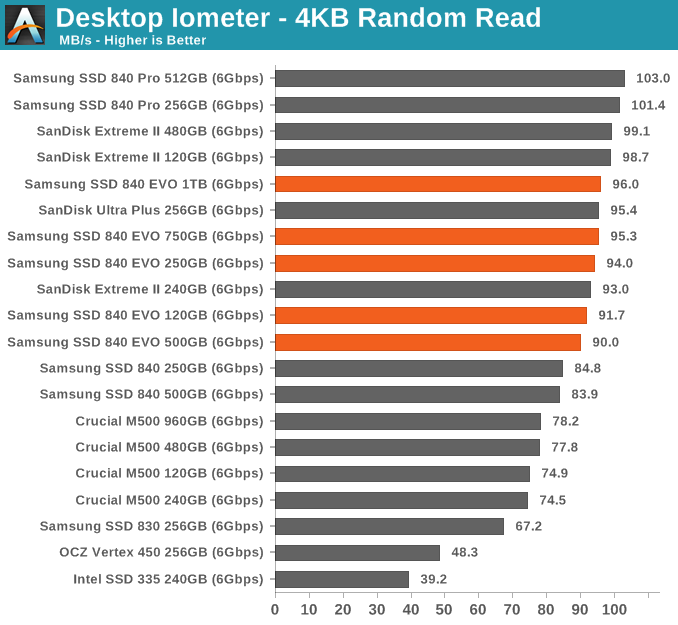
Random read speed is very close to that of the 840 Pro. The EVO doesn't look like a mainstream drive here at all.
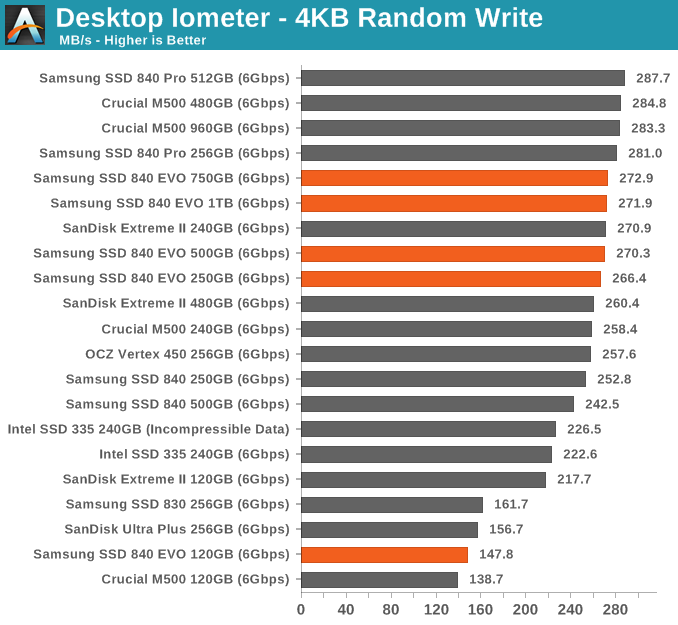
Even peak random write performance is dangerously close to the 840 Pro. Only the 120GB drive shows up behind the pack. I should add that I'll have to redo the way we test 4KB random writes given how optimized current firmwares/architectures have become. The data here is interesting but honestly the performance consistency data from earlier is a better look at what happens to 4KB random write performance over time.
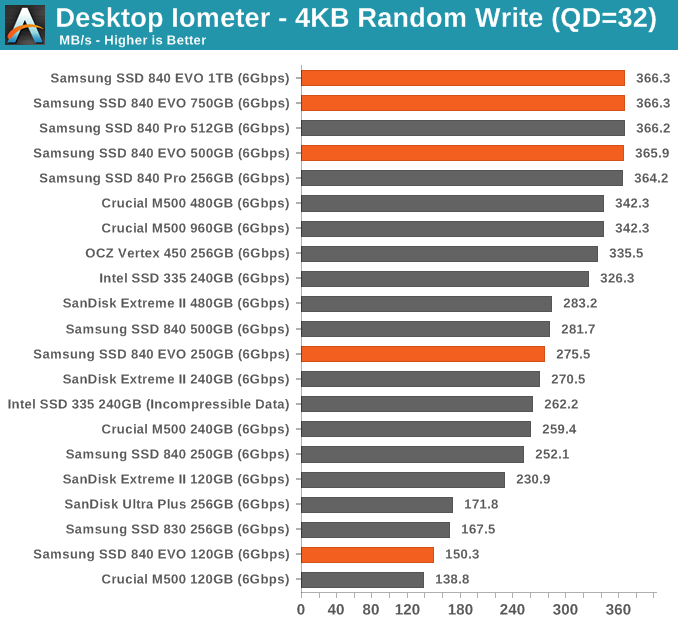
The relatively small difference between QD3 and QD32 random write performance shows you just how good of a job Samsung's controller is doing at write combining. At high queue depths the EVO is just as fast as the 840 Pro here. So much for TLC being slow.
Sequential Read/Write Speed
To measure sequential performance I ran a 1 minute long 128KB sequential test over the entire span of the drive at a queue depth of 1. The results reported are in average MB/s over the entire test length.
Sequential read and write performance, even at low queue depths is very good on the EVO. You may notice lower M500 numbers here than elsewhere, the explanation is pretty simple. We run all of our read tests after valid data has been written to the drive. Unfortunately the M500 attempts to aggressively GC data on the drive, so even though we fill the drive and then immediately start reading back the M500 is already working in the background which reduces overall performance here.
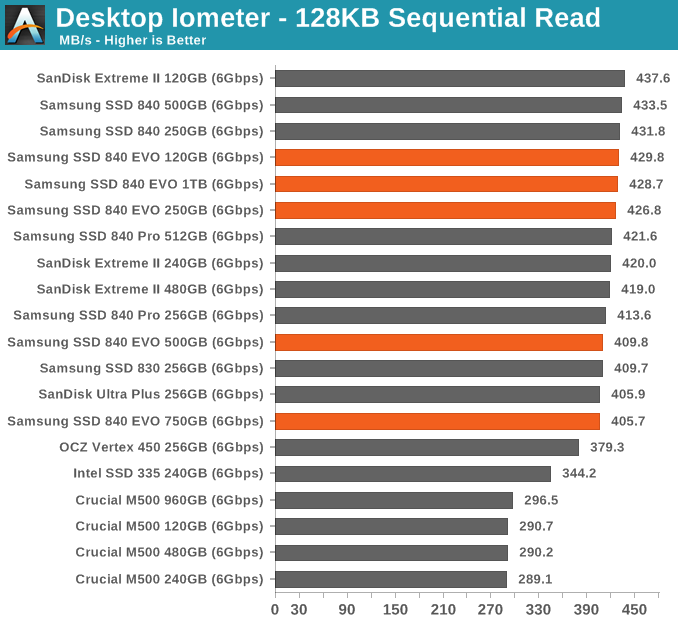
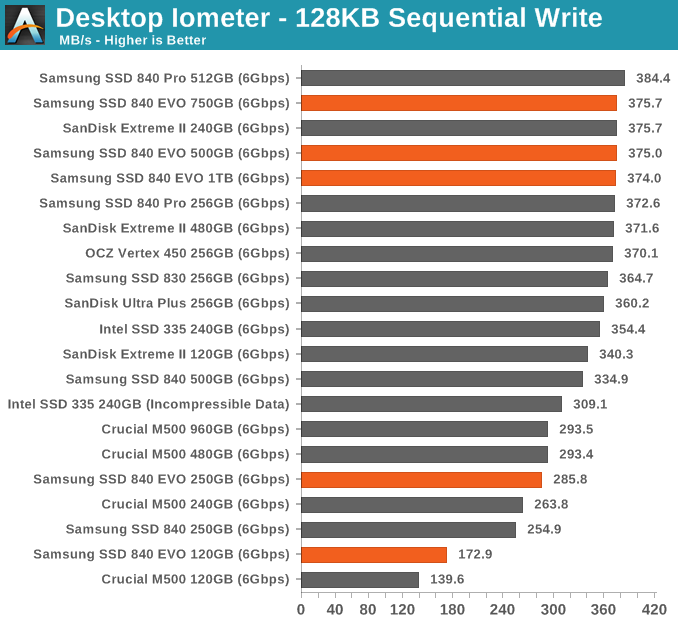
AS-SSD Incompressible Sequential Read/Write Performance
The AS-SSD sequential benchmark uses incompressible data for all of its transfers. The result is a pretty big reduction in sequential write speed on SandForce based controllers.
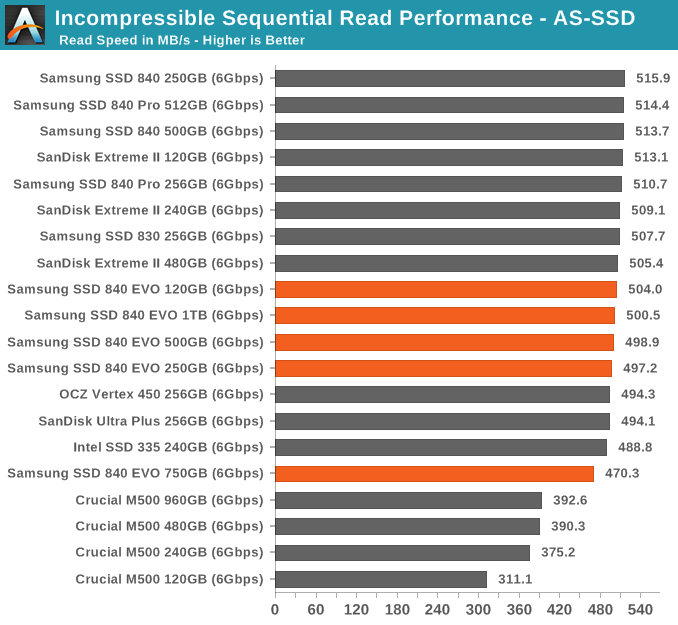
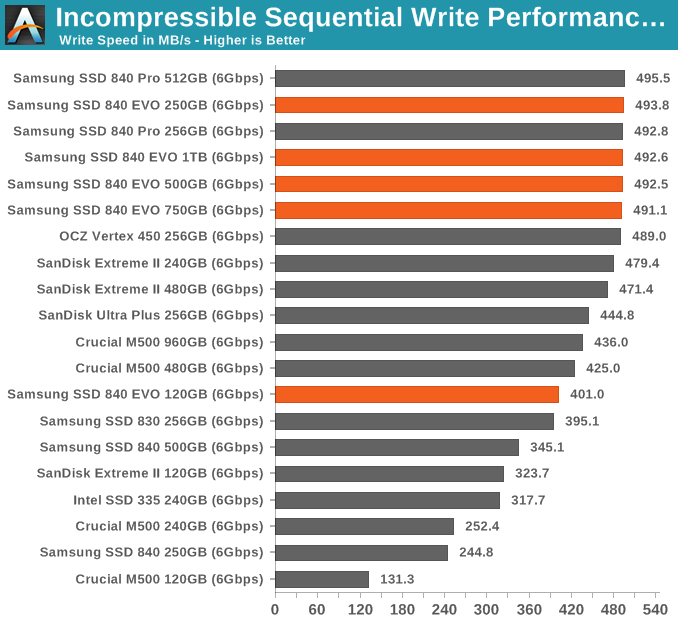










137 Comments
View All Comments
verjic - Thursday, February 13, 2014 - link
I'm talking about 120 Gb versionverjic - Thursday, February 13, 2014 - link
Also what is Write/Read IOMeter Bootup and Write/Read IOMeter IOMix - what means their speed? Thank YouAhDah - Thursday, May 15, 2014 - link
The TRIM validation graph shows a tremendous performance drop after a few gigs of writes, even after TRIM pass, the write speed is only 150MBps.Does this mean once the drive is 75%-85% filled up, the write speed will always be slow?
I'm tempted to get Crucial M550 because of this down fall.
njwhite2 - Wednesday, October 15, 2014 - link
Kudos to Anand Lal Shimpi! This is one of the finest reviews I have ever read! No jargon. No unexplained acronyms. Quantitative testing of compared items instead of reviewer bias. Explanation of why the measured criteria are imortant to the end user! Just fabulous! I read dozens of reviews each week, so I'm surprised I had not stumbled upon Anandtech before. I'm (for sure) going to check out their smartphone reviews. Most of those on other sites are written by Apple fans or Android fans and really don't tell the potential purchaser what they need to know to make the best choice for them.IT_Architect - Thursday, October 22, 2015 - link
I would be interested in how reliable they are. The reason I ask is one time, when the time the Intel SLC technology was just under two years old, and there was no MLC or TLC, I needed speed to load a database from scratch 6 times an hour during incredible traffic times. I was getting requests by users at the rate of 66 times a second per server, which each required many reads of the database per request. I couldn't swap databases without breaking sessions, and mirror and unmirror did not work well. I would have to pay a ton to duplicate a redundant array in SSDs. Then I asked the data center how many of these drives they had out there. They (SoftLayer) queried and came back with 700+. Then I asked them how many they've had go bad. They queried their records and it was none, not so much as a DOA. I reasoned from that I would be just as likely to have a chassis or disk controller go bad. None of them have any moving parts, and the drives are low power. Those were enterprise drives of course because that's all there was at that time.In 2011 I bought a Dell M6600. Dell was shipping them with the Micron SSD. I was concerned about the lifespan and I do a lot of reading and writing with it and work constantly with virtual machines while prototyping, and VM files are huge. It calculated out to 4 years. While researching, I came across that situation where Dell had "cold feet" about OEMing them due to lifespan. Micron/Intel demonstrated to them 10x the rated lifespan, which convinced Dell. There was plenty of other trouble with consumer-level SSDs at the time, which gave the technology a bad name. The Micron/Intel was one of the very few solid citizens at the time. I went with it, although I didn't buy my M6600 with it because Dell had such a premium on them. I had two problems with the drive, which by the way is still in service today. The first was the drive just stopped doing anything one day. I called Micron and it turned out to be a bug in the firmware. If I had two drives arrayed, it would have stopped both at the same time. I upgraded the firmware and never had that problem again. The next time I was troubleshooting the laptop and putting the battery in and out and the computer would no longer boot. I again called Micron. It was by design. They said disconnect the power, pull the battery, and wait one hour. I did, and it has worked perfectly since. If I had an array, it would have stopped both at the same time.
Today, the market is much more mature and the technology no longer has a bad name. A redundant array is no substitute for a backup anyway. A redundant array brings business continuity and speed. Are we just as likely or more so to have a motherboard go out? We don't have redundant motherboards unless without having another entire computer. Unlike a power supplies and CPUs, SSDs are low-current devices. I'm considering the possibility that we may be at the point, even for consumer-level drives, where redundant arrays for SSDs are just plain silly.
Gothmoth - Sunday, January 8, 2017 - link
in real life my RAPID test showed no benefits AT ALL!!all it does is making low level benchmarks look better.
you should test with real applications. RAPID is a useless feature.
jeyjey - Friday, June 7, 2019 - link
I have one of this drive. I need to find a little part that is fired, I need to replace it to try to enter the data inside. Please help.